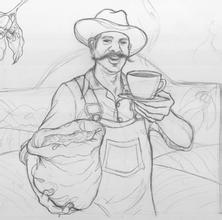A Brief Introduction to the Flavor Description of Coffee Beans Made in Yunnan Province
Introduction of Coffee production in Yunnan
Ding Ruirong, director of the Wanning Municipal Bureau of Industry and Science and Technology Information Industry, told reporters that in 2009, the local government launched coffee planting subsidies in order to support the coffee industry. At that time, it helped farmers to grow nearly 300 mu of coffee. This batch of coffee only began to hang fruit last winter and this spring. "in 2009, the government also subsidized the existing coffee land at that time, subsidizing 365 mu, mainly in Xinglong overseas Chinese farms. Therefore, it can be judged that even if statistical omissions are added, the area of hanging fruit coffee trees at that time is no more than 500 mu.
On the whole, until this year, the area of coffee trees that can hang fruit in Wanning City is only about 700 mu to 800 mu. According to the annual output of 100 kilograms of dried beans per mu, the total annual output of dried coffee beans is only 80 tons.
The same thing happened at Fukuyama Coffee. According to the reporter's investigation, before 2010, the planting area of coffee trees in Chengmaifu Mountain was about 1000 mu. In recent years, nearly ten thousand mu of new plants have been planted with policy support, but so far there has not been a large number of fruits. In other words, the current annual output of dried Fushan coffee beans is only about 100 tons. But at present, Chengmai has six large-scale coffee processing and operating enterprises, with annual coffee sales of more than 1000 tons.
Most of Asia is robusta coffee, which is used for instant coffee, while American futures coffee is Arabica coffee, which is mainly produced in Latin America. However, this kind of coffee tree is prone to leaf rust and has poor adaptability to the environment. Although nearly 70 countries around the world produce and export coffee beans, their output and quality vary. But it is clear that coffee producing countries are generally developing countries, while coffee consuming countries are those developed countries.
Since Brazil is the world's largest producer of coffee beans, there is a high chance that prices will hit a low during the April-August harvest, especially between June and July, and then gradually stabilize, reaching a high between January and February of the following year. this is because winter in the northern hemisphere is the biggest consumption season for coffee beans. Vietnam, Indonesia, India and other countries in Asia are also among the top ten countries in the world in terms of output. Affected by the El Ni ñ o drought, the yield and quality will be reduced. Most of the coffee in Vietnam is Robusta coffee, mainly distributed in the Xiyuan region, also known as the "western plateau". In the southwest of the Changshan Mountains, including Vietnam's Calais-Kunsong, Dorothy, Lintong and other provinces. The coffee in India is mainly Arabica coffee, while Robbist coffee was introduced at the end of the 19th century and accounted for a certain proportion. Indonesia's Mantenin coffee is mainly produced in Sumatra. Sumatra is the largest coffee producing area in Indonesia. Sumatra's coffee includes Arabica and Robusta, 90% of which is robusta. Arabica is usually grown at high altitudes in the mountains, while Robusta is planted in the lowlands. The second is the coffee trees planted in the north-south and east-west directions of Sulawesi and Java, which produce Robusta, and there is no difference in yield. This is the orange fruit obtained by the Coffee Institute of Chulvado in a test lung. The trial material is a rejuvenated coffee tree. It is said that the coffee trees that plant in the east-west direction seem to grow more vigorously than those in the north-south direction six months after they are cut off and pull out new branches, but by the second apple, this advantage has disappeared. When they were young, the plant growth in the north-south direction was poor at first because it was sheltered by the nearby unpruned coffee trees, resulting in less exposure. In the same study, the effects of the number of direct dried stems on coffee yield were also compared. It was observed that the plants with 3-5 channels of dust drying were indeed higher than those of plantations with only 1 or 2 tracks. The planting distance of the second area is 3 x 3 Yan and the algal shielding degree is 5. One 60%

Important Notice :
前街咖啡 FrontStreet Coffee has moved to new addredd:
FrontStreet Coffee Address: 315,Donghua East Road,GuangZhou
Tel:020 38364473
- Prev

Introduction to the Variety characteristics of Coffee Flavor description method in Sidamo Shachisuo, Ethiopia
Sidamo coffee beans Ethiopia is the hometown of Arabica coffee, and it is in the forests of the Kaffa region that you can see wild Arabica coffee. In Ethiopian, coffee is called Bun or Buna, and coffee beans (coffeebean) may be translated from Kaffa Bun. Arabica was discovered early in Harald (Harar).
- Next

Introduction to the characteristics of Coffee Flavor description and treatment in Fenghuang Manor, Costa Rica
Fire Phoenix Manor in Costa Rica is located in the fertile hills of the Poas volcano in the central valley of Costa Rica. It is the first producer in Central and South America to produce honey treatment and sun-cured coffee. It is a completely 100% organically cultivated coffee manor. The owner thinks that organic farming is a better choice for environmental maintenance and family health, even in the face of
Related
- Detailed explanation of Jadeite planting Land in Panamanian Jadeite Manor introduction to the grading system of Jadeite competitive bidding, Red bid, Green bid and Rose Summer
- Story of Coffee planting in Brenka region of Costa Rica Stonehenge Manor anaerobic heavy honey treatment of flavor mouth
- What's on the barrel of Blue Mountain Coffee beans?
- Can American coffee also pull flowers? How to use hot American style to pull out a good-looking pattern?
- Can you make a cold extract with coffee beans? What is the right proportion for cold-extracted coffee formula?
- Indonesian PWN Gold Mandrine Coffee Origin Features Flavor How to Chong? Mandolin coffee is American.
- A brief introduction to the flavor characteristics of Brazilian yellow bourbon coffee beans
- What is the effect of different water quality on the flavor of cold-extracted coffee? What kind of water is best for brewing coffee?
- Why do you think of Rose Summer whenever you mention Panamanian coffee?
- Introduction to the characteristics of authentic blue mountain coffee bean producing areas? What is the CIB Coffee Authority in Jamaica?

